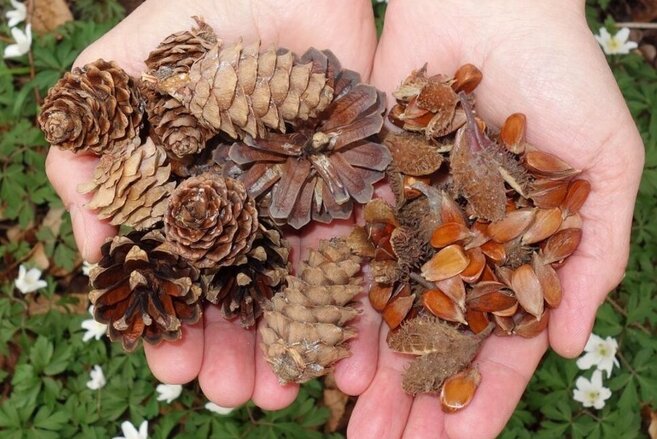

Institut für
FG Forstgenetik
Projekt
Holzherkunftsidentifizierung von Eichen und Lärchen (Deutsch-Russisch-Amerikanische Kooperation)
US-amerikanisches, russisches, deutsches Forschungsprojekt zur Unterstützung abgesicherter Holzhandelsketten mit genetischen Methoden
Für verschiedne Lärchen und Weiß-Eichenarten werden die Methoden und Referenzdaten zur Holzarten und Holzherkunftsidentifizierung entwickelt.
Hintergrund und Zielsetzung
TheU.S. Government together with the von Tünen Institute of Forest Genetics in Germany propose to launch a scientific partnership with Russia, Germany, and the U.S. to support collaboration between leading scientists and institutions to help lay the groundwork for developing a DNA-based solution to ensure a robust, reliable and sustainable supply of forest products from temperate and boreal regions worldwide. This partnership would support a pilot study focusing on Russian Larch (Larix sibirica, Larix gmelinii) and Mongolian Oak (Quercus mongolica) logged in the Russian Far East), along with scientific exchanges between Russian academic institutions and those in the partner countries to develop the application of cutting-edge technologies for genetic verification of commercial tree species.
In this pilot study Larch is included because this genus represents a large proportion of the timber imports from Russia to China (20%) and is of significant economic value for the US and EU market (figure 1). There are big differences in wood quality among the different Larch species and there are re-imports of processed timber from China to the USA and the EU declared as European larch and American larch. Thus it is important to have efficient genetic tools to control both the species and the geographic origin. Moreover there are already a few genetic studies done on the Larch species present in Russia that provide an optimal starting point for the gene marker development, genetic species identification (DNA barcoding) and the creation of a genetic reference data base to control timber origin (Araki et al. 2008, Smerikov et al, 2003 & 2007). In June 2011 the vTI starts already a first sampling campaign and genetic screening with a Russian team to collect Larch samples along a 8000 km transect from the Ural mountains to the very far east of Russia (figure 3).
A second species included into the pilot study is Mongolian Oak (Quercus mongolica). This is an important tree species for habitat of the Amur Tiger particularly in the regions Primorsky Kray, Khabarovski Kray and Amurskaya. It provides a food source for ungulates that are preyed upon by the tiger. Further, Mongolian Oak is often targeted in illegal logging operations in mixed forests. WWF-Amur branch mentioned that Mongolian oak is often logged illegally in Russia but then declared as originating in China where a legal supply exists; therefore, utilizing genetic verification to differentiate between oak logged in Russia or China could potentially be effective in the prosecution of a Lacey Act case involving the Russian supply chain. This is also a species for which some basic genetic studies have already been done in Japan (Ohsawa et al 2011 a, b), China (Zeng et al. 2010) and in the Far East of Russia (Potenko et al. 2007).
The Russian team of Proj Yulai Yanbaev in Ufa and the group of the vTI involved in this pilot study have a lot of experiences with sampling in the forests in Russia for genetic studies (Buschbom et al. 2011, Redkina et al. 2008, Schroeder et al. 2010).
Vorgehensweise
Deliverables of the project
Gene markers and genetic reference data base of Larix sibirica, Larix gmelinii and Quercus mongolica integrated into the open access data base at Bioversity International. These gene markers and the reference data base enable to control the geographic origin of Larch with an estimated spatial resolution of 200 km in the Far East of Russia and should enable the control if traded oak wood includes Quercus mongolica from the Russian regions Primorsky Kray, Khabarovski Kray and Amurskaya.
- DNA extraction protocols for un-processed and processed timber of Larch and Quercus. This extraction protocol is important to apply the developed tolls of the project on timber.
- Scientist from the USA and Russia trained in the application of DNA tools for timber tracking
- A publication or technical report summarizing program results and conclusions.
The project will make a significant impact on cross border smuggling and timber laundering. As a major genographic map it is step towards a global genetic map of forest resources for conservation and support of legal and sustainable sources.
The geographic database of Larix sibirica, Larix gmelinii and Quercus mongolica will enable:
- Tests of sawn timber in log yards and at point of export from Russia
- Tests of sawn timber at point of import to the EU or China
- Tests within factories in China (potentially contractually required by a US buyer)
- The potential to develop tests on finished product at point of import into the USA
Further outcomes of the project will include:
- Improved methodologies for DNA extraction from softwood trees
- A genetic reference database that will:
- It publically accessible and managed by Bioversity International
- Permits verification of species
- Permits verification of country of origin
- Allows identification of region down to a resolution of 250 – 300km
Thünen-Ansprechperson

Thünen-Beteiligte
Beteiligte externe Thünen-Partner
-
Bashkir State University
(Ufa, Russische Föderation) -
USDA Forest Service
(Corvallis, Washington D.C., Vereinigte Staaten von Amerika) -
Russian Academy of Sciences
(Ufa, Russische Föderation)
Geldgeber
-
US Forest Service - International
(international, öffentlich)
Zeitraum
3.2012 - 6.2015
Weitere Projektdaten
Projektstatus:
abgeschlossen
Publikationen zum Projekt
- 0
Schröder H, Cronn R, Yanbaev YA, Jennings T, Mader M, Degen B, Kersten B (2016) Development of molecular markers for determining continental origin of wood from White Oaks (Quercus L. sect. Quercus). PLOS One 11(6):e0158221, DOI:10.1371/journal.pone.0158221
- 1
Dormontt EE, Boner M, Braun B, Breulmann G, Degen B, Espinoza E, Gardner S, Guillery P, Hermanson JC, Koch G, Lee SL, Kanashiro M, Rimbawanto A, Thomas D, Wiedenhoeft AC, Yin Y, Zahnen J (2015) Forensic timber identification: it's time to integrate disciplines to combat illegal logging. Biol Conserv 191:790-798, DOI:10.1016/j.biocon.2015.06.038






